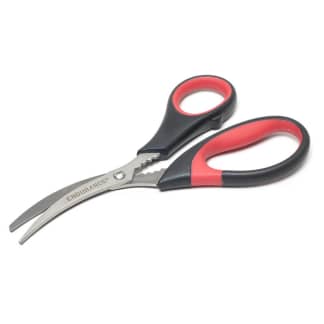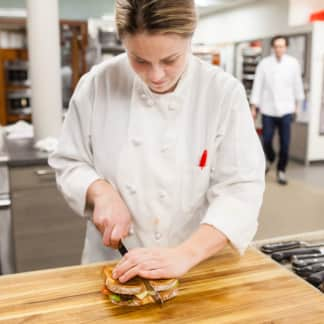The best shears can perform tasks large and small, delicate and tough. They’re sharp, powerful, and can be used comfortably by cooks with different dominant hands. The Shun Multi-Purpose Shears ticked all those boxes and more, earning our top ranking. Our Best Buy is the J.A. Henckels International Take-Apart Kitchen Shears. They're a touch less sharp and powerful than our favorite, but still performs admirably, especially for their lower cost.

Kitchen shears are an essential component of any cook’s knife kit. We use them for cutting twine and parchment, snipping herbs, trimming pie dough, cutting florets from heads of cauliflower and broccoli, and butterflying chickens, to name just a few. They also help us open food packaging and cut other non-food materials.

How Shears Work
Each pair of shears has two blades. The first is a cutter blade, which has a smooth edge that has been ground to a specific angle on both sides, similar to the blade of a chef’s knife (see “Sharp Cutter Blades” below). Unsurprisingly, the cutter blade is responsible for most of the cutting action. The “anvil” blade, by contrast, is usually serrated and a bit thicker, the better to help grip and secure the food being cut. The blades are attached at a pivot, and the handles of the shears act as levers, forcing the blades together to cut whatever you want.
What to Look For
- Sharp Cutter Blades: While cutter blades are generally sharpened to a wide edge angle (traditionally 50 to 70 degrees), we found that the narrower the angle on the blade, the sharper it was and the more easily it sliced through food. Not all manufacturers were willing to disclose edge angles, but our favorite model had a relatively acute angle of 19 degrees, providing a knife-like sharpness (for comparison, chef’s knives are typically sharpened to about 15 to 20 degrees). And although narrower edge angles can make some blades more vulnerable to chipping or scratching, our winner remained intact and razor-sharp throughout testing.
- Anvil Blades with Deep, Sharp Serrations on the Edge: The type and placement of serrations on the anvil blades mattered too. For the serrations to truly bite into and stabilize the food, they had to be on the edge of the blade or at least on the bevel. And the deeper and sharper the serrations, the more securely they held the food.

- Long, Narrow Blades: The blades on the models we tested ranged from 3 to 4 inches long. While that’s a seemingly small difference, extra length helped; we preferred blades of at least 3.5 inches, as they made longer, smoother strokes through food. We also prized narrower blades, which felt more agile and were easier to maneuver around food, allowing us to get into a head of cauliflower to snip off florets.
- Moderate Weight: We liked shears that were not too light (sacrificing power) or too heavy (taxing hands): 4 to 5 ounces was ideal.
- Models with Medium Tension: We preferred shears whose pivot (the central screw, or fulcrum) held the blades together with a medium level of tension that didn’t loosen throughout testing. This medium tension made it easy to open and close the shears and summon the requisite shearing force necessary to cut food.
- Comfortable, Ambidextrous Grips: Several of the shears we tested had handles (or “bows”) covered in plastic for a softer, more textured grip. This made them easier to hold and operate, especially when wet. We also preferred moderately sized finger bows: roomy enough for large hands to not feel cramped but not so big that smaller hands struggled to find position. And we liked that all but one of the models in our lineup were ambidextrous, with identically-sized bows on both sides that allowed both left- and right-handed users to wield them.
- Take-Apart Design: We strongly preferred shears that could be easily separated for easy cleaning. Take-apart models allowed users to get rid of any chicken or herb bits that got stuck at the pivot, making it easy to sanitize and reuse the shears. And despite our fears, no take-apart models accidentally separated during use if we opened them too wide.

What to Avoid
- Dull Cutter Blades: Cutter blades with thicker edge angles (more than 30 degrees) tended to wedge themselves into the food instead of cutting it, making most tasks slower and more difficult.
- Anvil Blades with Dull, Rounded Serrations: The shears that struggled most on tough and slippery food had duller serrations or didn’t have proper serrations at all. Instead, they sported rounded, granton-like indentations on the side of the anvil blade, away from the edge and bevel—which added little to no gripping power.
- Shorter, Wider Blades: While blades longer than 3.5 inches smoothly sailed through food, those measuring under 3.5 inches made shorter, stumpier cuts that felt less fluid. Wider blades (those measuring more than 0.75 inches across) added to this awkwardness, making it more difficult to nimbly navigate the contours of foods and fit into small gaps.
- Too Much (or Not Enough) Tension: If the shears were held together by central pivots with too much tension, they were difficult to open, close, and operate. Too little tension made them difficult to control and make precise cuts with. In a few cases, the tension loosened over the course of testing; since none of the models can be adjusted, we preferred shears that maintained their tension.
- Uncomfortable Grips: Shears with overly large finger bows forced users with smaller hands to struggle to find effective hand positions. Handles with small bows were uncomfortable for most testers to use, as they generally cramped hands and limited the grip options. We also disliked handles made of slick metal, which were difficult to grip and manipulate when wet.
The Tests
- Test initial sharpness by cutting paper
- Cut parchment rounds
- Cut kitchen twine
- Snip chives
- Trim rosemary branches
- Trim pie crust
- Cut whole head of cauliflower into florets
- Cut 3 whole chickens into parts; trim parts
- Test with users of different hand sizes and dominant hands
- Test sharpness again by cutting paper
How We Rated
- Ease of Use: We evaluated how easy the shears were to use and how comfortable they were to hold for users of different hand sizes and dominant hands.
- Performance: We rated the shears on how well they cut different foods and materials.
























